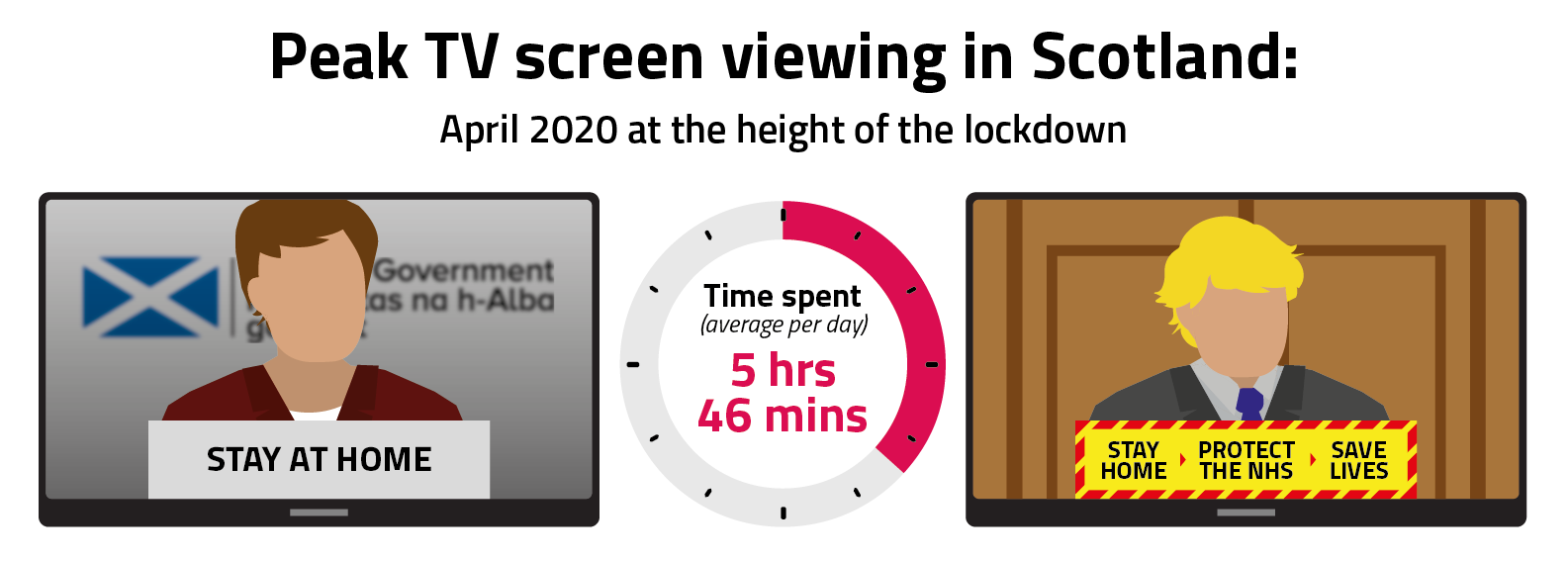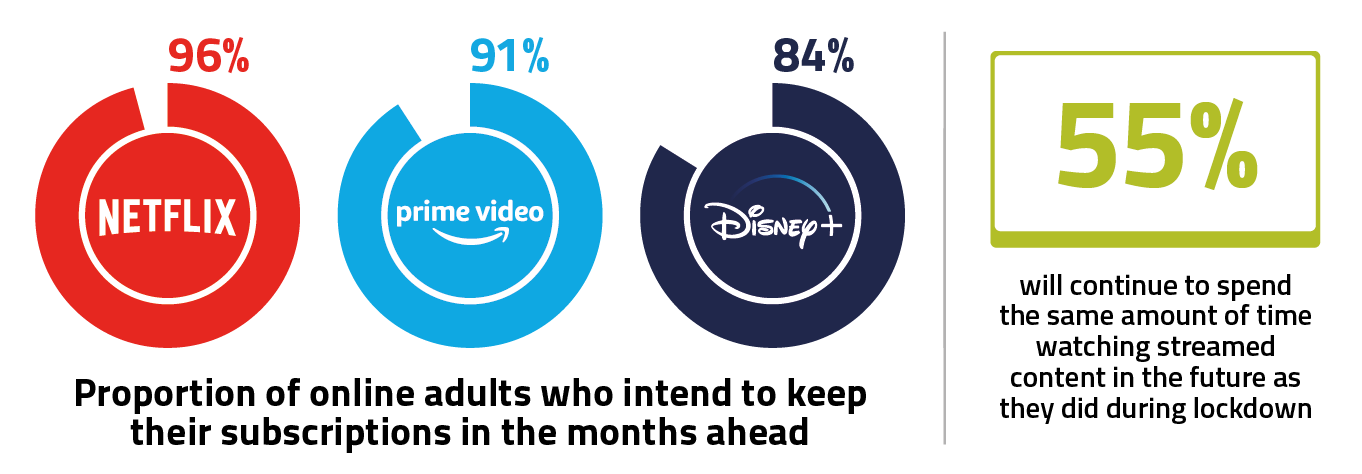Lockdown leads to surge in TV screen time and streaming in Scotland
- People spend nearly six hours a day in front of the TV during height of lockdown
- Time on non-broadcaster content like YouTube and Netflix nearly doubles during pandemic
- Nearly entire online population followed news updates during early weeks of the crisis
A surge in screen time during lockdown saw people in Scotland spend nearly six hours a day watching TV and online video services on the TV set, Ofcom has found in its annual study of the nation’s media habits.
As people across Scotland followed official health advice to stay home during April 2020, they kept themselves informed and entertained by spending 5 hours and 46 minutes each day on average – or 40 hours a week – watching broadcast TV, online video content and gaming[1] – a rise of a third (33%) on last year.[2]

The biggest factor behind this increase was people in Scotland spending nearly twice as much time (+87%) watching video-on-demand services such as Netflix, Disney+, YouTube and other non-broadcast content – an hour and 37 minutes per day on average in April 2020.[3]
However, broadcast TV viewing retained the largest share of daily time spent with the TV during peak lockdown – reaching an average of 3 hours and 59 minutes in April 2020 (+18% compared with 2019).[4]
Traditional broadcasters hit record share… driven by demand for news
Ofcom's Media Nations: Scotland 2020 report[5] finds that when lockdown was announced towards the end of March, average daily viewing of broadcast television peaked at 4 hours 26 minutes in Scotland, driven by demand for the latest news on the pandemic. This was the highest level of viewing of all the UK Nations.
News programming on TV reached an average of 74% of the population in Scotland each week in March 2020, although this decreased to 69% by June.
The BBC proved to be the most popular source of news about the pandemic overall in Scotland; more than seven in 10 online adults used its TV, radio and online services from the early weeks of lockdown through to mid-June. In comparison, six in 10 online adults in Scotland (59%) used non-BBC broadcaster services - mainly STV - during the first four weeks of lockdown, but this had decreased to five in 10 (51%) by mid-June.
The demand for trusted news about the pandemic meant that the public service broadcasters – the BBC, STV, ITV, Channel 4, Channel 5 – grew their combined monthly share of broadcast TV viewing across Scotland to 59% in March 2020 (up from 57% in February).
...but PSBs face ongoing financial and production challenges
But the boost to the PSBs’ audience figures during lockdown was short-lived, as the pandemic interrupted production of soaps, major sporting events and entertainment shows. By June 2020 their combined monthly share of broadcast TV viewing across the UK fell to 55%, its lowest level since August 2019.
The outlook for commercial public service broadcasters PSBs is especially tough, as they manage cost-cutting measures amid financial uncertainty. Their cumulative revenues declined by 3.5% in 2019 to £2.2bn, and TV advertising revenues are expected to fall 17-19% in 2020.
Growth in paid-for streaming services
Across the UK, an estimated 12 million adults signed up to a new video streaming service during lockdown, of whom around 3 million had never subscribed to one before.[6]
Disney+, which launched on the first day of the UK’s lockdown, made an immediate impact. The new service attracted 16% of online adults by early July across the UK, surpassing NOW TV (10%) to become the third most-popular subscription streaming service behind Netflix (45%) and Amazon Prime Video (39%).
Among children aged 3-11, Disney+ was used in a third of homes (32%) by June – overtaking BBC iPlayer which saw use among these children fall from 26% to 22% during the spring.
...leads to loyalty after lockdown
While viewing to traditional broadcast television declined from its early lockdown peak, the uplift in viewing of video-on-demand and other non-broadcast content in Scotland has held steady, at 84% higher than the year before.[7]

And our adoption of streaming services appears likely to continue after lockdown. The overwhelming majority of online adults across the UK signed up to Netflix (96%), Amazon Prime Video (91%) and Disney+ (84%) said they plan to keep their subscriptions in the months ahead.
Similarly, more than half of UK adults (55%) say that they will continue to spend the same amount of time watching streamed content in future as they did during lockdown.
Glenn Preston, Ofcom Scotland Director, said: “While following advice to stay indoors during peak lockdown, people in Scotland relied on the TV to keep informed and entertained, from the First Minister’s daily updates to escapist content like Tiger King on Netflix.
“The pandemic showed public service broadcasting at its best, but UK broadcasters face a tough advertising market, production challenges and financial uncertainty. They need to keep demonstrating that value in the face of intense competition from streaming services.”
NOTES TO EDITORS
- Figure includes live viewing, time-shifted viewing up to 28 days after the original broadcast, other broadcaster content such as boxsets on BVOD services that haven’t had a linear broadcast and ‘unmatched content’ like subscription video-on-demand services, YouTube, gaming, viewing DVDs/box sets/archives, time-shifted viewing beyond 28 days, apps on smart TVs and navigation around EPG guides where there is no in-picture broadcast content on the TV set.
- People in Scotland spent an average of 4 hours 21 minutes per day watching TV, online video and other content on the main TV in the home in 2019 – 85 minutes less than in April 2020.
- People in Scotland spent 52 minutes watching ‘unmatched’ content in 2019 – 45 minutes less than in April 2020.
- Broadcast viewing consolidated to seven days after broadcast.
- This is Ofcom’s third annual Media Nations: Scotland report, a reference publication for industry, policy makers, academics and consumers. It reviews key trends in the TV and online video sectors, as well as the radio and other audio sectors. Accompanying this narrative report is an interactive report that includes an extensive range of data. There are also separate reports for the UK (PDF, 2.6 MB), Northern Ireland (PDF, 2.5 MB) and Wales (PDF, 3.7 MB). We have also today published a qualitative research report: Children’s Media Lives – Life in Lockdown to seek to understand how the pandemic has changed children’s media use and how they behave and interact online.
- Before lockdown, 56% of households in Scotland already subscribed to subscription-on-demand services, with nearly half of homes having access to Netflix (49%).
- People in Scotland spent an average of 79 minutes watching ‘unmatched’ content each day in week 26 of the year (week beginning 22 June 2020) compared to 43 minutes in the same week of 2019.